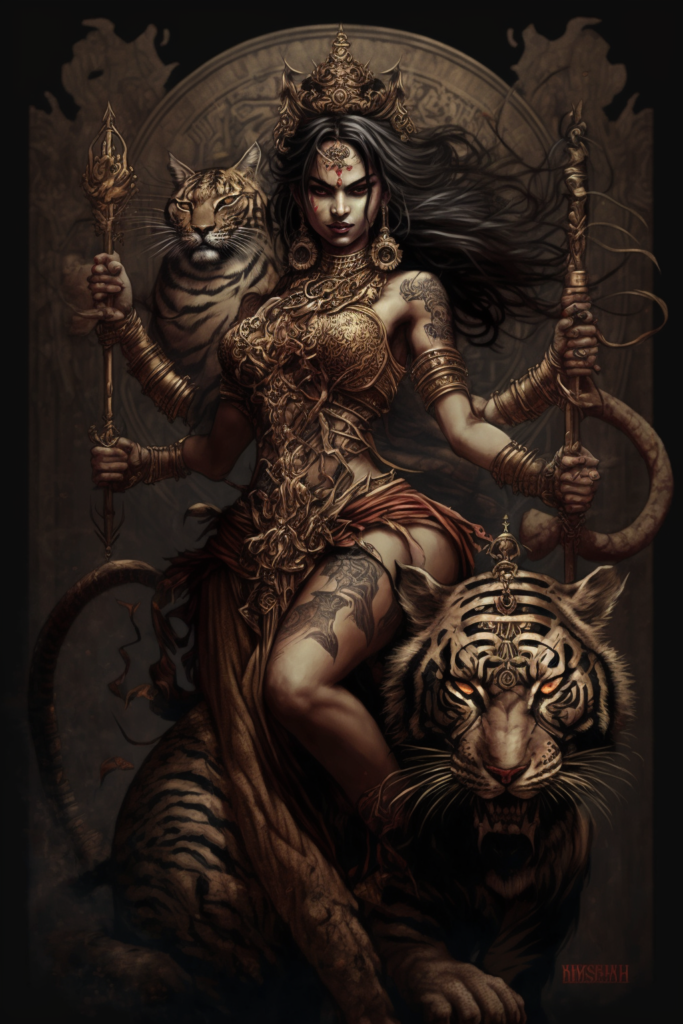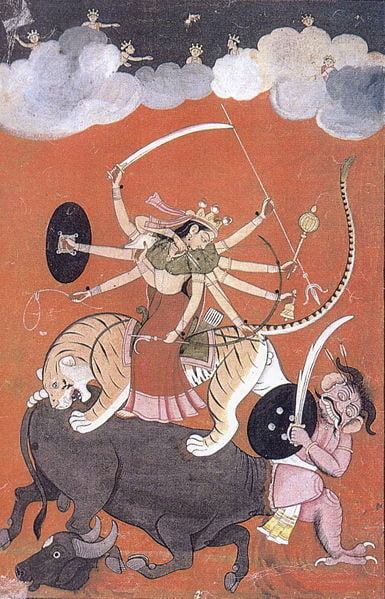Goddess, Durga (Mother Goddess, Divine Feminine)

Durga is a powerful and complex Hindu goddess, revered for her divine strength and fierce protection. Her name means “invincible,” and she is often depicted riding a tiger or lion, carrying weapons in multiple arms.
- Pantheon: Hindu
- Deity Title: Durga, Mother Goddess, Divine Feminine
- Deity Symbol: Trishul, Lotus, Conch Shell, Thunderbolt, Sword
- Home Plane: Kailash
- Deity Level: Intermediate
- Alignment: Lawful Good
- Aliases: Devi, Shakti, Mahamaya, Adi Parashakti, Amba, Parvati
- Superior: None
- Traditional Allies: Shiva, Vishnu, Brahma, Ganesh, Kartikeya
- Traditional Foes: Mahishasura, Durgam, Raktabija
- Divine Artifact: Sudarshana Chakra, Trishul, Conch, Lotus
- Servants: Nandi, Durga’s lion, Ganesha, Skanda, Shiva
- Servitor Creatures: Yakshas, Kinnaras, Gandharvas
- Sacred Animal: Lion, Tiger
- Manifestations: Mahishasuramardini, Mahakali, Annapurna, Chandi, Bhavani, Jagadamba, Ambika, Lalita
- Signs of Favor: Triumph over evil, protection of the weak, successful endeavors
- Worshipers: Hindus, particularly in Bengal, Orissa, and other eastern Indian states; practitioners of yoga and meditation
- Cleric Alignments: Lawful Good, Neutral Good
- Specialty Priests: Witch doctors, healers, protectors
- Holy Days: Navaratri, Durga Puja
- Portfolio: Protection, victory over evil, motherhood, creation, balance, compassion
- Domains: Protection, Good, Law, War, Healing
- Favored Weapon: Trishul
- Favored Class: Cleric
- Favored Race: Human
- Duties of the Priesthood: Protecting the weak, battling evil, upholding the law, providing healing and comfort
- Major Cult/Temple Sites: Vaishno Devi, Kamakhya Temple, Dakshineswar Kali Temple, Kalkaji Mandir, Tarapith
- Benefits: Increased protection, healing powers, enhanced combat ability, blessings for successful endeavors
According to Hindu mythology, Durga was created by the gods as a warrior to battle the demon Mahishasura, who was wreaking havoc and threatening the balance of the universe. She is often depicted as a fierce and powerful warrior, with ten arms wielding a variety of weapons.
But she is more than just a warrior goddess – she also embodies the qualities of motherhood and compassion. In some stories, she is portrayed as a loving mother figure, protecting her children and offering comfort and guidance.
Durga’s ultimate goal is to restore order and balance to the world. As a protector of the weak and innocent, she fights against injustice and oppression, using her strength and cunning to defeat those who would harm the innocent.
Throughout history, she has been a source of inspiration and empowerment for women, particularly in India. Her fierce spirit and unyielding determination have been a symbol of strength for women facing adversity and oppression.
As a divine figure, Durga has many worshippers, particularly in India and Nepal. She is often called upon for protection, especially in times of crisis or danger. Her devotees seek her blessings and guidance, and she is often invoked through prayer and ritual.
Durga is typically depicted as a beautiful and powerful goddess with multiple arms, each holding a different weapon, symbolizing her ability to fight and protect. She is often portrayed riding a lion or tiger, which represents her courage and strength. Her skin is said to be golden or radiant, and her clothing and adornments are ornate and regal, befitting of her divine status. Durga’s face is serene and benevolent, yet also fierce and determined, reflecting her complex nature as a goddess of both compassion and power.
Durga is a complex and powerful figure, embodying both strength and compassion. She is a symbol of hope and protection for many, inspiring her followers to fight for justice and stand up against oppression.

In the clouds the Devas, celestial beings watching the event, are seen.
The story is written in the Devi Mahatmya and Devi Bhagavata and
is the background of the Durgapuja, the annual hindufestival in autumn.

 Buy me a coffee
Buy me a coffee